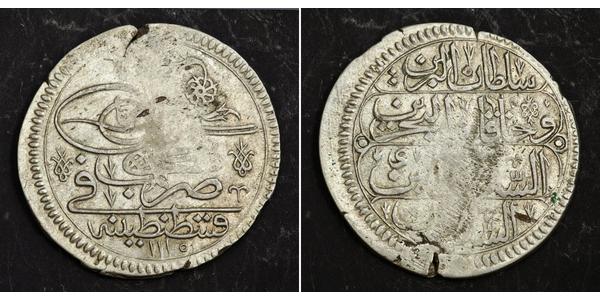(sold for $16.0)
1715, Ottoman Empire, Sultan Ahmed III. Silver Yirimlik (½ Kurush). Large Planchet!
Reference: KM-153. Denomination: Yirimlik (½ Kurush) Mint Place: Qustantiniya (Constantinople) Mint Period: 1703-1730 (AH1115-AH 1143) Condition: Weakly struck areas due to a shallow planchet (possibly caused by the large dies which squeezed the planchet to a large and thin size), minor deposits. otherwise XF! Weight: 13,08gm Diameter: 34mm Material: Silver
Obverse: Thughra (state seal of the Sultan) above mint name (Qustantiniya) and accession year (1115AH).
Reverse: Four lines of Kufic inscriptions.
em>.
Ahmed III (Ottoman Turkish: احمد ثالث Aḥmed-i sālis) (December 30/31, 1673 – July 1, 1736) was Sultan of the Ottoman Empire and a son of Sultan Mehmed IV (1648–87). His mother was Mâh-Pâre Ummatullah (Emetullah) Râbi'a Gül-Nûş Valide Sultan, originally named Evmania Voria, who was an ethnic Greek. He was born at Hajioglupazari, in Dobruja. He succeeded to the throne in 1703 on the abdication of his brother Mustafa II (1695–1703). Nevşehirli Damat İbrahim Pasha and his daughter, Hatice Sultan (wife of the former) directed the government from 1718 to 1730, a period referred to as the Tulip Era.
Ahmed III cultivated good relations with France, doubtless in view of Russia's menacing attitude; in fact, both his wives were Frenchwomen. He afforded refuge in Ottoman territory to Charles XII of Sweden (1682–1718) after the Swedish defeat at the hands of Peter I of Russia (1672–1725) in the Battle of Poltava of 1709. In 1710 Charles XII convinced Sultan Ahmed III to declare war against Russia, and the Ottoman forces under Baltacı Mehmet Pasha won a major victory at the Battle of Prut. In the aftermath, Russia returned Azov back to the Ottomans, agreed to demolish the fortress of Taganrog and others in the area, and to stop interfering in the affairs of the Polish–Lithuanian Commonwealth.
Forced against his will into war with Russia, Ahmed III came nearer than any Ottoman sovereign before or since to breaking the power of his northern rival, whose armies his grand vizier Nevşehirli Damat İbrahim Pasha succeeded in completely surrounding at the Pruth River Campaign in 1711. The subsequent Ottoman victories against Russia enabled the Ottoman Empire to advance to Moscow, had the Sultan wished. However, this was halted as a report reached Constantinople that the Safavids were invading the Ottoman Empire, causing a period of panic, turning the Sultan's attention away from Russia.
Sultan Ahmed III had become unpopular by reason of the excessive pomp and costly luxury in which he and his principal officers indulged; on September 20, 1730, a mutinous riot of seventeen Janissaries, led by the Albanian Patrona Halil, was aided by the citizens as well as the military until it swelled into an insurrection in front of which the Sultan was forced to give up the throne.
Ahmed voluntarily led his nephew Mahmud I (1730–54) to the seat of sovereignty and paid allegiance to him as Sultan of the Empire. He then retired to the Kafes previously occupied by Mahmud and died at Topkapı Palace after six years of confinement.
The reign of Ahmed III, which had lasted for twenty-seven years, although marked by the disasters of the Great Turkish War, was not unsuccessful. The recovery of Azov and the Morea, and the conquest of part of Persia, managed to counterbalance the Balkan territory ceded to the Habsburg Monarchy through the Treaty of Passarowitz, after the Ottoman Empire was defeated in Austro-Turkish War of 1716–18. In 1716, he sent an army of 33,000 men to capture Corfu from the Republic of Venice.
Ahmed III left the finances of the Ottoman Empire in a flourishing condition, which had remarkably been obtained without excessive taxation or extortion procedures. He was a cultivated patron of literature and art, and it was in his time that the first printing press authorized to use the Arabic or Turkish languages was set up in Constantinople, operated by Ibrahim Muteferrika (while the printing press had been introduced to Constantinople in 1480, all works published before 1729 were in Greek, Armenian, or Hebrew).
It was in this reign that an important change in the government of the Danubian Principalities was introduced: previously, the Porte had appointed Hospodars, usually native Moldavian and Wallachian boyars, to administer those provinces; after the Russian campaign of 1711, during which Peter the Great found an ally in Moldavia Prince Dimitrie Cantemir, the Porte began overtly deputizing Phanariote Greeks in that region, and extended the system to Wallachia after Prince Stefan Cantacuzino established links with Eugene of Savoy. The Phanariotes constituted a kind of Dhimmi nobility, which supplied the Porte with functionaries in many important departments of the state.
Only 1$ shipping for each additional item purchased!

|
Posted by:
anonymous 2018-10-09 |
4 Groschen Kingdom of Prussia (1701-1918) Silver Frederick W ...
group has 6 coins / 5 prices
⇑







-300-150-sSshwJfl8_cAAAGL1F9TnYK4.jpg)






